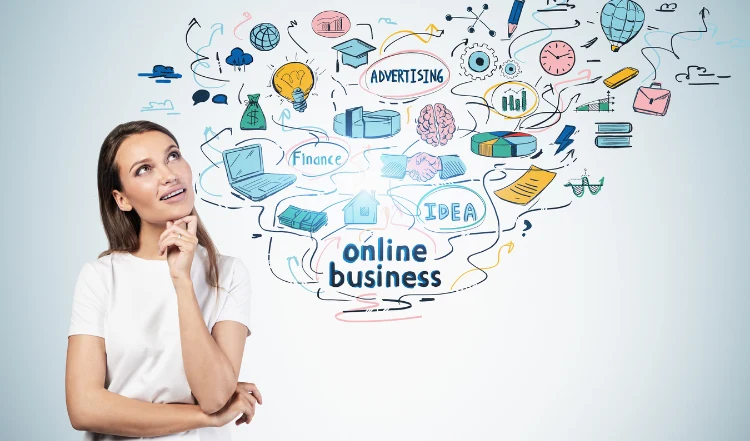Table of Contents
Step 1: What Is Your Passion?
The number one thing I like to start with, is choosing a passion I love. This way, working from here on out won’t feel like work. So, the first thing I want you to do, is to strongly consider your hobbies.
What are they? What other skills do you have that make you unique?
Once you figure out your own passion, you can start using it to direct your online business.
For example, a good friend worked at a tour agency. Not a travel agent. A company that specializes in creating niche tourist packages like Step Back In Time To Ancient Rome, or 14 Days On The Orient Express.
My friend loved travelling and built up a substantial expertise relating to all things travel. She’s been traveling every month because it’s her passion. At first, she took pictures and blogged about her adventures and offered some insanely helpful insider travel tips. And she started to earn money through offers she was monetizing while writing.
Jump forward 18 months or so and she’s built up a respectable following on TikTok and Instagram, monetized her YouTube channel as a newly minted YouTube Partner, landed a few sponsorships, earns affiliate income from her blog and socials, and sells some seriously amazing printables on Etsy.
Remember, you don’t need to be an expert on a topic to provide value. This is a common misconception and deterrent for getting started. Of course, you have value, and chances are that you probably don’t realize just how much you know compared to the next person who could really use your help!
If you’re still stumped and can’t think of anything. Consider this:
What life experience do you have that you could help others attain or overcome?
When starting an online business, you want to think about your passion and its potential in the market. This brings us to your next step, market fit.
Step 2: Who Is Your Market?
When you’ve narrowed in on your passion and skill set, the next stepping stone is understanding the market you’re about to work in. You want to learn who these people are who will be interested in your valuable work.
- Who would benefit from your knowledge?
- Is the market size big enough for you to profit from it?
- Where can you most likely find this type of person?
Let’s take an example.
Say your unique skill is you’ve mastered vegan cooking.
There are several people who can benefit from your expertise. To name a few, people who are lactose intolerant or people who avoid eating meat for health or religious reasons. This is likely a very large market, with a lot of potential to profit.
The best and easiest way to find out for sure is using the Google Keyword Planner.
You can go here to get to Google’s Keyword Planner: https://adwords.google.com/home/tools/keyword-planner/
Now that we know how to determine our market fit and potential, we can start to get into the head of these potential customers and better understand their needs. This brings us to our next step, creating an avatar.
Step 3: Your Ideal Customer
An avatar is a single person that embodies the representation of your ideal customer.
Any good business starts with catering to their customer, that’s why this step is vital to creating a successful product and marketing strategy.
You must understand your customer’s needs and fears, so you get down to how you can better help him/her.
What age is your ideal customer? Are they male or female?
What are their biggest problems as they relate to your solution?
Where would you be able to find your ideal customer (sites, communities, etc.)?
If you do a good job of defining your avatar, then they will become as real to you as a real customer. You should be able to narrow in on the type of language they will be most responsive to be able to know what keeps them up at night, what would motivate them.
In turn, you’ll be able to structure your product with the right pain points and solutions that will be delivered in a way that will resonate with your potential customer.
Now that you better understand how to narrow in on your ideal demographic, let’s talk about building a list of prospects in our next step on building a following.
Step 4: Building a Following
A following is a group of people who are interested in your content and who will want to stay updated on the information you will share with them.
You want to cultivate a strong relationship with these people because they will look to you as an authority figure and will in turn seek and take your advice.
This means that later down the road when you want to make a recommendation to them about a product you will be offering, they will trust you.
Your following are your future potential buyers. There are numerous outlets where you can build a following.
You will recognize them by the names of major social media platforms YouTube, Instagram, Facebook, but also including various online forums and sites. You can even start to build a following offline through your communities, interest groups, etc.
The best place to start is where you think most of your prospective buyers will be. This may be in a particular Facebook group, maybe it’s Instagram because you have a young demographic, or it may even be so specific as in your local communities, like a self-help book club, etc.
You can really think outside the box here.
So what do you start with?
Start by cultivating a relationship with those people. Maybe you start that Facebook group or Instagram page and start inviting or following people who would be interested in your content. Maybe you start publishing cooking videos on YouTube. Maybe you start commenting on a forum and building authority among its users.
The point here is to find where your prospective buyers are and start an outlet of communication with them, so you can build rapport. Give them value, and they’ll want consistent communication from you, where you’ll eventually be able to sell targeted offers to them. Before we do that, though, we need to first build a list of prospective buyers.
Step 5: Building a List of Prospective Buyers
Now that you understand the importance of building your community of prospective buyers, you probably realize that you’ll need a way to organize them to be able to deliver offers in the future.
The way by which you turn a prospective buyer into a lead and in turn into a customer is with what we call, in digital marketing, a funnel.
In this specific case, you will want to set up an opt-in funnel.
An opt-in funnel is a series of pages you set up, the goal of which is to obtain the email address of your potential buyer. You want to collect a list of emails, so you can communicate and build a relationship with those leads—and email is the best way to do that!
The most important part of all of this is the opt-in form that asks them for their name and email so that you can send them regular newsletters and updates. You can set up easy opt-in forms using Leadpages or MailerLite or Aweber or GetResponse – there are plenty of options.
Now, not everyone will go around handing you their email just because you ask them.
That’s where you must deliver valuable content—this is your knowledge on whatever passion, skill, or interest you homed in on in Step 1. This includes tips, advice, blueprints, or any other related know-how that they’d be interested in a simple PDF format—yep, it’s that easy.
The delivery method? Email, of course! You can use any email provider to help you get those emails out, such as Aweber Email Autoresponder—it’s easy for beginners and free to use, too!
Step 6: Monetizing Your Audience
Now that you know how to start a following and a way to reach that following with just a click of a button, you might be thinking, “How do I get to the money part?”
A rookie mistake is to start monetizing too early.
Another rookie mistake?
Taking too long to monetize. So, let’s start with a baseline.
You want to send your list free content emails before you start sending them promotional ones. These can be short articles you send them; PDF reports you link off to, or even videos that you find on YouTube that you think will be helpful to your subscribers.
It doesn’t have to be content you create, but it does need to be content that they find valuable. You’ll want to send at least two free content pieces before asking for anything in return.
Start with value and reciprocity will follow. With ClickBank, you can earn commissions up to 75% on products you promote from the ClickBank Marketplace. The key to navigating the ClickBank Marketplace is to start with the category your subscribers are most likely to be interested in.
From there, you’re most likely going to find the best converting products at the top of the list. These are the products that are selling the most for our affiliates and are most likely going to pump out the most bang for your promotional buck.
You can also try JVzoo or WarriorPlus and find products there where you can promote and generate commissions from. Once again, covering any niche you like. Mostly in the Work from Home niche and covering software solutions as well.
A couple of tips:
ClickBank affiliates usually look for products with a gravity of 10 or higher. This means that at least 10 different affiliates are promoting the product and making sales regularly for it. Other things to look out for are if the product offers re-billing commission, which means the product owner has a product that bills the customer each month, and they’re willing to give you a percent of what’s earned – month after month.
With these tips, you’ll be promoting the top products which are most likely to convert your subscribers into commissions and even make you some recurring income along the way!
After you get up and going, you’ll want to think about how to scale your efforts. That’s in our next steps.
Use also Muncheye.com to find out who and what is launching in the IM Space (covering jvzoo, warrior + and clickbank)
Step 7: Scaling Your Profits
Now you’re dialed in with the whole “make money online” thing… how do you scale?
There are two main ways to make more money, which generally applies to any business.
- Get more customers
- Make more money per customer
So how can you apply this?
One way to get more customers is to increase your focus on Step 4—building your following. You should always be growing your following and as a result growing your list. A way to make more money per customer is by continuing to give great value to your subscribers so that they want to buy from you repeatedly.
But there’s even a bigger way to scale your profits…
Instead of being an affiliate and driving traffic to ClickBank products for a commission, you can be the product owner and have affiliates drive traffic for you and make you sales!
By packaging your own product as a PDF, audio, or video series, you can sell to your subscribers and keep 100% of the profits.
With your own product, you can have affiliates sell your product for you. There are around 100,000 active affiliates on ClickBank looking for interesting, high-converting products to promote to their following, just like you!





